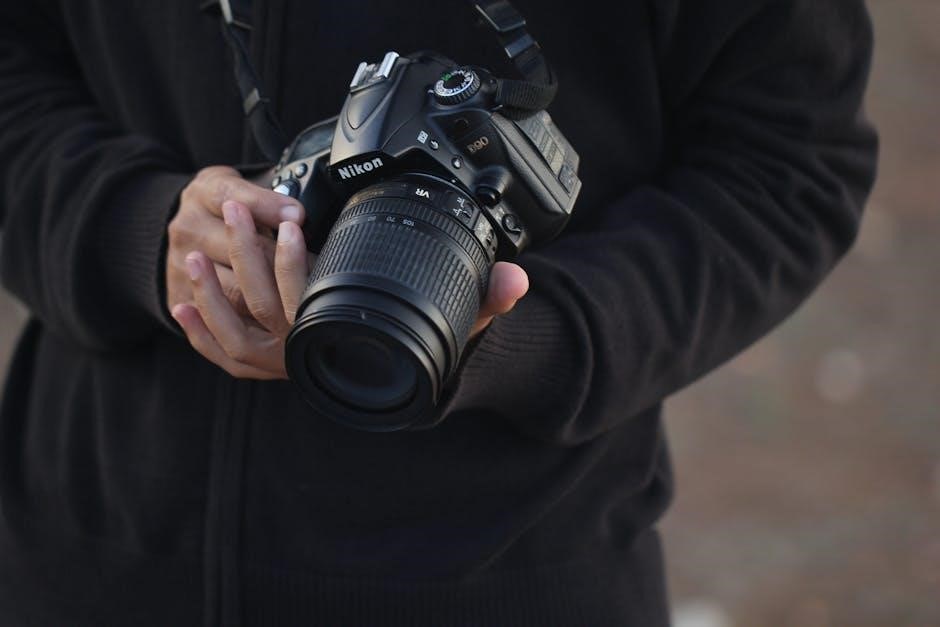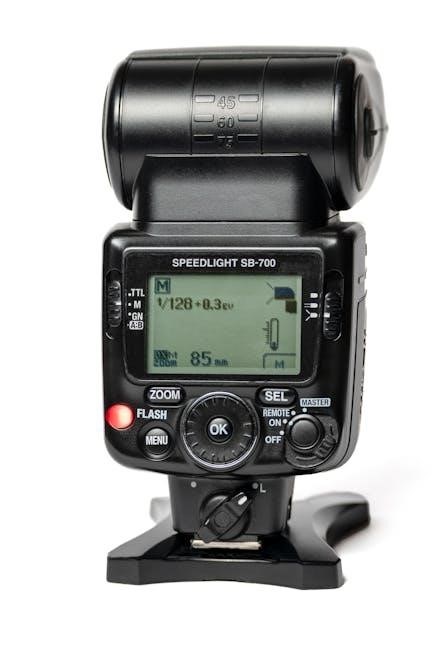The Nikon FM2 is a classic 35mm SLR camera renowned for its mechanical shutter, lens compatibility with AI, AI(S), and D-Type lenses, and exceptional durability.
1.1 Overview of the Nikon FM2 Camera
The Nikon FM2 is a highly regarded 35mm single-lens reflex (SLR) film camera known for its durability and mechanical reliability. Introduced as part of Nikon’s iconic FM series, it features a robust build quality and a wide range of compatible lenses, including AI, AI(S), and D-Type lenses. The camera is celebrated for its mechanical shutter, which can reach speeds of up to 1/4000th of a second, making it versatile for various lighting conditions. Its design emphasizes simplicity and functionality, appealing to both professionals and enthusiasts. The FM2 remains a popular choice among film photographers due to its reliability and compatibility with a wide range of Nikon accessories and lenses.
1.2 Importance of the Instruction Manual
The Nikon FM2 instruction manual is essential for maximizing the camera’s potential and ensuring proper operation. It provides detailed guidance on features like aperture priority mode, manual metering, and lens compatibility. Understanding the camera’s mechanical shutter, exposure modes, and metering system requires clear instructions. The manual also helps troubleshoot common issues and explains maintenance procedures. For both beginners and experienced photographers, it serves as a comprehensive reference, ensuring optimal performance and preventing errors. Using the manual guarantees a seamless shooting experience with this iconic film camera.

Key Features of the Nikon FM2
The Nikon FM2 features a mechanical shutter, wide ISO range, lens compatibility, built-in metering, and battery-free operation. Its robust design and portability make it versatile and reliable.
2.1 Mechanical Shutter and Speed Range
The Nikon FM2 boasts a mechanically controlled shutter system, offering exceptional reliability and precision. It features a wide speed range of 1/4 second to 1/4000 second, plus a Bulb mode for extended exposures. This mechanical design allows the camera to function without battery power, ensuring operation even in the absence of electricity. The fast shutter speeds, particularly 1/4000 second, make it ideal for freezing motion and capturing sharp images in bright lighting conditions. This robust mechanism is a hallmark of the FM2’s durability and versatility for photographers seeking manual control and reliability.
2.2 Lens Compatibility (AI, AI(S), and D-Type Lenses)
The Nikon FM2 is compatible with a wide range of lenses, including AI, AI(S), and D-Type lenses. This compatibility ensures versatility for photographers, allowing the use of both older and newer Nikon optics. The camera supports AI and AI(S) lenses with full aperture indexing, enabling accurate metering and exposure control. D-Type lenses also work seamlessly, providing advanced communication between the lens and camera. This broad compatibility makes the FM2 a flexible choice for photographers who value access to a diverse selection of high-quality optics.
2.3 Metering System and Exposure Control
The Nikon FM2 features a center-weighted metering system, providing accurate exposure measurements by prioritizing the central area of the frame. This intuitive system is ideal for photographers seeking balanced exposures, especially in complex lighting conditions. The camera offers a wide exposure range of -2 to +19 EV, ensuring flexibility in various lighting scenarios. Exposure compensation of up to ±2 stops allows for precise adjustments, enabling photographers to fine-tune their results effortlessly. This system, combined with manual controls, makes the FM2 a reliable tool for achieving desired exposure outcomes.

Camera Construction and Ergonomics
The Nikon FM2 is built with a durable, all-metal body, ensuring long-lasting performance. Its ergonomic design provides a comfortable grip and intuitive control placement for easy operation.
3.1 Build Quality and Durability
The Nikon FM2 is renowned for its exceptional build quality, featuring a robust copper-aluminum alloy construction that ensures durability and withstands heavy use. Weather-sealed to protect against moisture and dust, the camera is designed for reliability in various environments. Its mechanical shutter operates smoothly, offering precise control and longevity. The FM2’s solid design and high-quality materials make it a reliable tool for photographers, capable of enduring years of use without compromising performance.
3.2 Layout of Controls and Dials
The Nikon FM2 features a well-organized layout of controls, designed for intuitive operation. The shutter speed dial is located on the top plate, offering easy access to various speeds. The mode dial allows switching between aperture priority and manual modes. The ISO/ASA setting is conveniently positioned for quick adjustments. The aperture ring is situated on the lens, enabling precise control over exposure. A metering switch is present for activating the light meter. The film advance lever and rewind knob are ergonomically placed for smooth film handling. The lens release button is located on the lens mount, facilitating easy lens changes.

Loading Film and Basic Shooting
Mastering film loading and basic shooting ensures seamless photography with the Nikon FM2. Properly load film, advance it to the first frame, and set the counter. Focus, compose, and shoot with precision, leveraging the camera’s intuitive design for optimal results.

4.1 Film Loading Process
Loading film into the Nikon FM2 is straightforward. Open the camera back by sliding the release latch. Insert the film cartridge, ensuring it aligns with the spool. Advance the film using the rapid advance lever until it reaches the first frame. Close the back and check the film counter to ensure it stops at “0” or “S.” Wind the lever once to chamber the first frame. The film is now ready for shooting. Always confirm the counter resets correctly to avoid exposure issues.
4.2 Setting the Film Speed (ISO)
Setting the film speed (ISO) on the Nikon FM2 ensures proper exposure. Locate the film speed ring around the lens mount. Pull and rotate it to align the desired ISO with the white dot. The FM2 supports ISO ranges from 12 to 4000. Ensure the ring clicks into place for accurate setting. This step is crucial for metering accuracy. Always verify the ISO matches your film type. Higher ISOs are ideal for low-light conditions. Refer to the film’s packaging for the correct ISO value to optimize results.
4.3 Basic Shooting Techniques
Mastering basic shooting techniques with the Nikon FM2 enhances your photography experience. Start by ensuring the camera is properly loaded and the film speed is set. Use the aperture and shutter controls to achieve desired exposures, or rely on aperture priority mode for convenience. Focus carefully using the split-image microprism in the viewfinder. Frame your shot, ensuring proper composition and lighting. Advance the film after each exposure and monitor the frame counter. Experiment with different techniques to refine your style and capture stunning images with precision and creativity.

Exposure Modes and Metering
The Nikon FM2 offers Aperture Priority and Manual modes, providing flexibility for photographers. Its center-weighted metering system ensures accurate exposure readings, enhancing creative control and precision.
5.1 Aperture Priority Mode
In Aperture Priority mode, the Nikon FM2 allows photographers to set the desired aperture, while the camera automatically adjusts the shutter speed to achieve optimal exposure. This mode is particularly useful for controlling depth of field, as the user can select the aperture to blur or sharpen backgrounds. The camera’s metering system calculates the appropriate shutter speed based on the selected aperture and film speed, ensuring balanced exposures. This mode is ideal for situations where aperture control is critical, such as portrait or landscape photography, offering a blend of creative control and automation.
5.2 Manual Mode and Metering
In Manual Mode, the Nikon FM2 offers full control over both aperture and shutter speed, allowing photographers to fine-tune exposures based on the built-in light meter. The meter provides LED indicators to signal overexposure, underexposure, or correct exposure. This mode is ideal for experienced photographers who prefer precise control, especially in challenging lighting conditions. The camera does not automate any settings, requiring manual adjustments to achieve the desired exposure. This mode emphasizes the photographer’s skill and understanding of light, making it a favorite for those seeking creative freedom.
- The meter guides exposure decisions but does not set them automatically.
- LED arrows indicate whether the exposure is too high or low.
- Manual mode is best suited for experienced photographers.
5.3 Using the Built-in Light Meter
The Nikon FM2 features a built-in center-weighted light meter for accurate exposure measurements. It measures light through the lens, ensuring precise readings. The meter is activated when the camera is cocked and ready to shoot. LED indicators in the viewfinder show overexposure (red +), underexposure (red -), or correct exposure (green dot). Adjust aperture or shutter speed based on the meter’s feedback. Ensure the lens is clean and avoid covering the meter with your hand or accessories for accurate readings. This system is reliable for both manual and aperture-priority modes.
- Center-weighted metering provides balanced exposure assessments.
- LED indicators guide adjustments for optimal exposure.
- Ensure proper meter operation by keeping the lens clean.

Focusing and Viewfinder
The Nikon FM2 offers precise focusing mechanisms and a bright viewfinder for clear composition. Its high-precision focusing screens and intuitive viewfinder design enhance shooting accuracy and comfort.
6.1 Focusing Screens and Types
The Nikon FM2 features interchangeable focusing screens, allowing photographers to tailor the viewfinder to their needs. The standard screen is the K-3 type, with a microprism collar for precise focus. Other options include the B-3 type for low-light conditions and the E-Type for wide-angle lenses. Each screen offers unique benefits, ensuring sharp focus and composing ease. The FM2’s modular design makes swapping screens straightforward, while the bright viewfinder provides a clear view of your subject and focus area, enhancing overall shooting accuracy and control. This adaptability makes the FM2 versatile for various photography styles.
6.2 Viewfinder Information and Display
The Nikon FM2’s viewfinder provides essential shooting information, including aperture, shutter speed, and exposure compensation. A built-in LED display shows metered exposures, while a split-image microprism center aids precise focusing. The bright, high-eyepoint design ensures easy composition, even for eyeglass wearers. The viewfinder also features a 93% frame coverage, allowing accurate framing. This intuitive layout helps photographers quickly assess settings and focus, making the FM2 a joy for precise and efficient shooting. Its clarity and functionality enhance the overall shooting experience, aligning with the camera’s reputation for reliability and user-centric design.

Accessories and Compatibility
The Nikon FM2 supports AI, AI(S), and D-type lenses, ensuring compatibility with a wide range of optics. Optional accessories like the MD-12 motor drive enhance functionality.
7.1 Compatible Lenses and Accessories
The Nikon FM2 is compatible with a wide range of lenses, including AI, AI(S), and D-type lenses, offering flexibility for various photographic needs. Accessories like the MD-12 motor drive, remote cords, and interchangeable focusing screens enhance functionality. The camera also supports Nikon’s dedicated flash units, ensuring seamless lighting control. With its robust accessory ecosystem, the FM2 remains versatile for both casual and professional use, making it a reliable choice for film photographers seeking adaptability and precision.
7.2 Using Flash and External Lighting
The Nikon FM2 is compatible with various Nikon flash units, such as the SB-15 and SB-16, which can be mounted on the camera’s hot shoe or connected via a sync cord. When using flash, set the shutter speed to 1/125 second or slower for proper synchronization. External lighting can enhance image quality by controlling shadows and highlights. Techniques like bounce flash and using diffusers or reflectors can create professional-looking results. Experimenting with different lighting setups allows photographers to achieve their desired aesthetic with the FM2.

Maintenance and Troubleshooting
Regular cleaning of the camera and lens prevents dirt buildup. Check shutter curtains for damage and ensure proper lubrication of mechanical parts. Inspect light seals for wear.
8.1 Cleaning the Camera and Lens
Regularly clean the Nikon FM2 to maintain its performance and image quality. Use a soft-bristled brush to remove dust from the exterior and viewfinder. For the lens, gently wipe with a microfiber cloth or lens tissue. Avoid harsh chemicals or abrasive materials. Clean the viewfinder with a dry, lint-free cloth. Never touch lens elements with bare hands, as skin oils can cause smudging. Store the camera in a cool, dry environment to prevent moisture buildup. Cleaning ensures optimal functionality and preserves the camera for long-term use.
8.2 Common Issues and Solutions
The Nikon FM2, like any mechanical camera, may encounter issues. Battery drain can occur if the meter is left on; always turn it off. Inaccurate meter readings may require manual mode adjustment. Shutter speed issues often result from worn parts and may need professional servicing. Light leaks can occur if the seals degrade; replace them promptly. Film advance problems may arise from dirt or improper loading; clean and reload film carefully. Addressing these issues ensures reliable performance and extends the camera’s lifespan for continued use.

The Nikon FM2 Legacy
The Nikon FM2 is a legendary camera, blending durability and precision, leaving a lasting impact on photography and remaining a favorite among film enthusiasts.
9.1 Historical Significance in Photography
The Nikon FM2, introduced in 1982, holds a revered place in photography history for its robust mechanical design and reliability. It became a favorite among professionals and enthusiasts alike, offering unparalleled durability and precision in harsh conditions. Its simplicity and focus on essential features made it a symbol of Nikon’s commitment to quality and innovation. The FM2’s legacy endures as a testament to the golden era of film photography, influencing countless photographers and remaining a sought-after camera for those who appreciate its timeless craftsmanship and functionality.
9.2 Popularity Among Film Enthusiasts
The Nikon FM2 remains a beloved choice among film enthusiasts due to its mechanical simplicity, reliability, and timeless design. Its all-mechanical shutter and battery-independent operation resonate with purists who value precision and durability. The camera’s intuitive controls and compatibility with a wide range of Nikon lenses further enhance its appeal. As film photography experiences a resurgence, the FM2 has become a sought-after model, cherished for its heritage and ability to deliver exceptional results in both casual and professional settings.
The Nikon FM2 is a legendary camera, blending mechanical excellence with durability. This manual ensures mastery of its features, unlocking its full potential for photographers seeking precision and artistry.
10.1 Final Thoughts on the Nikon FM2
The Nikon FM2 stands as a testament to timeless camera design, blending precision engineering with intuitive functionality. Its robust build and mechanical reliability make it a favorite among film enthusiasts. The manual’s guidance ensures photographers maximize the camera’s potential, whether in aperture priority or manual mode. For both professionals and hobbyists, the FM2 delivers exceptional results, embodying the essence of analog photography. Its enduring popularity underscores its value as a tool for creative expression and capturing life’s moments with unparalleled clarity.
10.2 Encouragement to Try the Camera
Experimenting with the Nikon FM2 is a rewarding experience that reconnects you with the fundamentals of photography. Its mechanical simplicity and tactile controls offer a unique, hands-on shooting experience. Whether you’re a seasoned photographer or just discovering film, the FM2’s intuitive design and reliability make it an excellent choice. Dive into the world of analog photography, embrace the creativity of manual controls, and discover the joy of capturing moments with a camera that has stood the test of time. Give it a try—you might just fall in love with the process.
